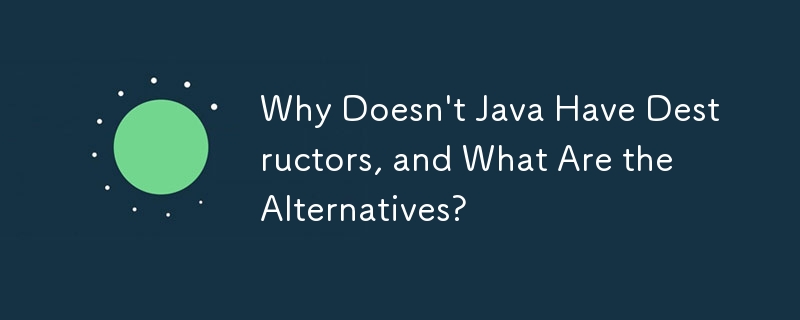Why Doesn\'t Java Have Destructors, and What Are the Alternatives?

Java's Lack of Destructors and Alternative Approaches
In Java, the concept of a destructor, a method executed upon object destruction, is not explicitly defined. This arises from Java's garbage collection mechanism, which automatically deallocates memory when objects are no longer referenced.
To achieve similar functionality, Java offers the finalize() method, an inherited method called implicitly just before an object is garbage collected. However, the timing and execution of finalize() is unpredictable and varies depending on the garbage collector implementation. Therefore, it's not recommended to rely on finalize() for resource cleanup or other critical tasks.
Instead, the recommended practice is to define a close() or dispose() method that explicitly releases resources when the object is no longer needed. For example, in your case, you could create a reset() method that nullifies references to data objects, triggering their eventual garbage collection. This ensures proper resource cleanup and prevents potential memory leaks.
It's important to note that garbage collection in Java is non-deterministic, meaning that objects may not be collected immediately when they become eligible. Repeatedly entering data and pressing the reset button may result in some memory consumption until garbage collection occurs. To manage this, you could consider using reference counting or weak references to explicitly track and clean up objects when their references are no longer active.
The above is the detailed content of Why Doesn\'t Java Have Destructors, and What Are the Alternatives?. For more information, please follow other related articles on the PHP Chinese website!

Hot AI Tools

Undresser.AI Undress
AI-powered app for creating realistic nude photos

AI Clothes Remover
Online AI tool for removing clothes from photos.

Undress AI Tool
Undress images for free

Clothoff.io
AI clothes remover

AI Hentai Generator
Generate AI Hentai for free.

Hot Article

Hot Tools

Notepad++7.3.1
Easy-to-use and free code editor

SublimeText3 Chinese version
Chinese version, very easy to use

Zend Studio 13.0.1
Powerful PHP integrated development environment

Dreamweaver CS6
Visual web development tools

SublimeText3 Mac version
God-level code editing software (SublimeText3)

Hot Topics
 1376
1376
 52
52
 How does Java's classloading mechanism work, including different classloaders and their delegation models?
Mar 17, 2025 pm 05:35 PM
How does Java's classloading mechanism work, including different classloaders and their delegation models?
Mar 17, 2025 pm 05:35 PM
Java's classloading involves loading, linking, and initializing classes using a hierarchical system with Bootstrap, Extension, and Application classloaders. The parent delegation model ensures core classes are loaded first, affecting custom class loa
 How do I implement multi-level caching in Java applications using libraries like Caffeine or Guava Cache?
Mar 17, 2025 pm 05:44 PM
How do I implement multi-level caching in Java applications using libraries like Caffeine or Guava Cache?
Mar 17, 2025 pm 05:44 PM
The article discusses implementing multi-level caching in Java using Caffeine and Guava Cache to enhance application performance. It covers setup, integration, and performance benefits, along with configuration and eviction policy management best pra
 How can I use JPA (Java Persistence API) for object-relational mapping with advanced features like caching and lazy loading?
Mar 17, 2025 pm 05:43 PM
How can I use JPA (Java Persistence API) for object-relational mapping with advanced features like caching and lazy loading?
Mar 17, 2025 pm 05:43 PM
The article discusses using JPA for object-relational mapping with advanced features like caching and lazy loading. It covers setup, entity mapping, and best practices for optimizing performance while highlighting potential pitfalls.[159 characters]
 How do I use Maven or Gradle for advanced Java project management, build automation, and dependency resolution?
Mar 17, 2025 pm 05:46 PM
How do I use Maven or Gradle for advanced Java project management, build automation, and dependency resolution?
Mar 17, 2025 pm 05:46 PM
The article discusses using Maven and Gradle for Java project management, build automation, and dependency resolution, comparing their approaches and optimization strategies.
 How do I create and use custom Java libraries (JAR files) with proper versioning and dependency management?
Mar 17, 2025 pm 05:45 PM
How do I create and use custom Java libraries (JAR files) with proper versioning and dependency management?
Mar 17, 2025 pm 05:45 PM
The article discusses creating and using custom Java libraries (JAR files) with proper versioning and dependency management, using tools like Maven and Gradle.




